| Conservation of the Lions Gate Section |

|
The Lions Gate section is the northern part of the city's eastern wall. The Temple Mount is located south of it. The northeastern corner of the city wall is founded on hewn bedrock, which probably served as part of the moat that encompassed the northern wall. Lions Gate is situated near the Temple Mount, in a spot where an entrance to the city had already been established in the Roman period.
Physical Data
The overall length of the city wall in the Lions Gate section is c. 360 meters. Its exterior facade measures c. 3,090 square meters in area. The city wall rises to a height of 7-11 meters above its surroundings and the Lions Gate stands 13.7 meters high.
The buildings of the Moslem Quarter adjoin the city wall's interior facade.
Conservation Values:
Historical Values. The gate was named the Lions Gate because of the lion reliefs that appear on the front of it. These reliefs are known to have been the symbol of Baybars, the Mamluk governor, and they were apparently incorporated in the city wall during the Ottoman period.
During the Six Day War in 1967 Israeli generals entered the Old City by way of the Lions Gate. A historic picture captures that moment when Moshe Dayan, Yitzhak Rabin and Uzi Narkiss were photographed with the Lions Gate appearing in the background (Fig. 1).
The gate was damaged during the war. Its lintel was partially destroyed and damage from where it was struck with bullets can still be seen today on the front of it. The lintel was restored after the war but the original section of that element can be distinguished from the part that was restored.
Urban Values. The entire eastern wall of the Old City can be seen from the Mount of Olives and because of this it has been depicted numerous times throughout history.
Lions Gate is situated in the center of the eastern wall and is the only entrance into the city from that direction.
Architectural Values. The fact that the city wall was made higher by means of quarrying the bedrock at the foot of it, in its northeastern corner, reflects the need for protection that the wall provided. In all likelihood this was part of a moat. There are marks on the inside of the gate indicating it was breached in order to create a direct axis into the city rather than the indirect entrance. The indirect gate structure reflects the architecture of the Ottoman period, whereas the breach reveals the changes that occurred at the end of the Ottoman period, a time when neighborhoods developed outside the city walls and its gates no longer fulfilled their original function.
The lion decorations surmounting the opening at the front of the gate, mentioned above in the historical values, are recognized as a symbol of Baybars, the Mamluk governor.
Physical Problems:
The state of preservation of the Lions Gate wall is defined as medium-low. Soot, which is a result of burning, is evident the length of the wall. The wall is defaced with patches of paint and graffiti.
The skyline is characterized by missing stonework and large parts of the wall's outline cannot be discerned. There are lacunae in the stone in the region where the wall is founded on the bedrock, and the stone surface beneath the wall is unstable.
Conservation Principles:
The Lions Gate city wall can be easily seen from afar and there is very little pedestrian traffic alongside it. It was therefore decided that the conservation of the city wall would consist of minimal intervention for constructive purposes only. This is unlike other sections of the city wall such as Damascus Gate and Ma'aleh Ha-Shalom where the wall was emphasized as an architectural element and is seen from up close. The Lions Gate wall underwent minimal treatment that was intended to make manifest the historical value and the changes of time which lend it authenticity. The only exception to this approach was the treatment of the gate, where conservation and restoration of decorations and stabilization of an embrasure were emphasized due to the structure's centrality and architectural-artistic value (Figs. 2-3).
Conservation Measures
1. Stabilizing the embrasure. The constructive state of the embrasure above the gate opening was unstable, probably due to the ravages of the battles that occurred there. At first the embrasure was documented, and afterward dismantled and rebuilt. Its construction included the completion of missing stonework and anchors were installed in order to achieve maximum and long-lasting stability (Figs. 4-9).
2. Gate decorations. Dirt and weathering that were visible in the gate decorations obscured the lion reliefs. The architectural-artistic value was reinforced by cleaning the reliefs and highlighting the decoration by means of emphasizing the lion relief located in the middle of the front facade (Figs. 9-10).
3. Completion of Stonework. Stones in many of the crenellations of the Lions Gate wall were missing or were in a deteriorated and unstable condition. In order to prevent water from penetrating into the core of the city wall and avoid further constructive deterioration, the existing stones were stabilized and new stonework was completed where needed (Figs. 12-14).
4. Restoration of a decorative flame. The crenellation above the gate, the embrasure, was adorned with a stone flame. Although it was not preserved it can be seen in pictures taken at the beginning of the Mandate period. The ornamentation was reconstructed according to historical pictures (Fig. 15).
5. Cleaning graffiti and patches of soot. Large portions of the Lions Gate wall close to the ground were covered with patches of soot and graffiti. These defacements on the surface of the city wall were steam-cleaned (Figs. 16-17).
6. Completion of pavement. This was done in the tower (Figs. 19-20).
7. Stabilizing bedrock. The surface of the bedrock at the foot of the city wall was unstable. The bedrock was stabilized and the interface between it and the wall was highlighted by means of mortar.
|
|
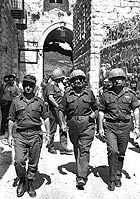
|
| 1. The generals entering through Lions Gate. 1967, the National Archive. |
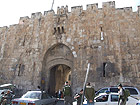
|
| 2. Lions Gate prior to conservation. 2010. Photograph: Yuval Abraham. |
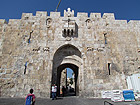
|
| 3. Lions Gate upon completion of the conservation work. 2012. Photograph: Yuval Abraham. |
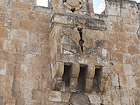
|
| 4. The embrasure prior to conservation. 2010. Photograph: Yuval Abraham. |
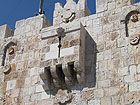
|
| 5. The embrasure upon completion of the conservation work. 2012. Photograph: Avi Mashiah. |
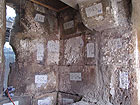
|
| 6. Numbering the stones of the embrasure before dismantling it. 2012. Photograph: Avi Mashiah. |
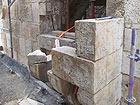
|
| 7. Dismantling the embrasure. 2012. Photograph: Avi Mashiah. |
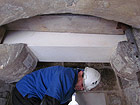
|
| 8. Installing the beam in the embrasure. 2012. Photograph: Avi Mashiah. |
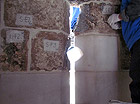
|
| 9. Assembling the embrasure and completing the stonework. 2012. Photograph: Avi Mashiah. |

|
| 10. The lion decorations prior to conservation. 2010. Photograph: Yuval Abraham. |

|
| 11. The lion decorations upon completion of the conservation work. 2012. Photograph: Avi Mashiah. |
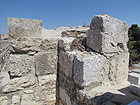
|
| 12. An embrasure prior to conservation. 2010. Photograph: Yuval Abraham. |
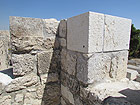
|
| 13. An embrasure upon completion of the conservation work. 2012. Photograph: Avi Mashiah. |
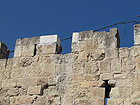
|
| 14. Completion of crenellations in the towers. 2012. Photograph: Avi Mashiah. |
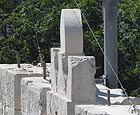
|
| 15. Completion of a decoration above the embrasure. 2012. Photograph: Avi Mashiah. |
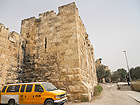
|
| 16. The tower prior to conservation. 2010. Photograph: Avi Mashiah. |
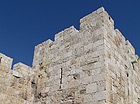
|
| 17. The tower upon completion of the conservation work. 2012. Photograph: Yuval Abraham. |

|
| 18. Dismantled pavement. 2010. Photograph: Yuval Abraham. |
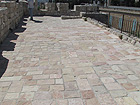
|
| 19. Completion of the pavement. 2012. Photograph: Yuval Abraham. |
|















